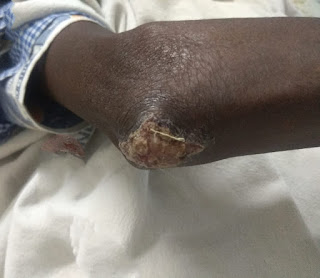A CASE WITH PAINFUL SKIN LESIONS PRESENTED IN SUMMER 2023
NOTE:
The following E-log aims at discussing our patient de-identified health data shared after taking the guardian's signed consent.
Here we discuss our individual patient problems through series of inputs from available global online community of experts with an aim to solve the patients clinical problem with current best evidence based input.
This E-log also reflects my patient's centered online learning portfolio.
I have been given this case to solve in an attempt to understand the topic of "Patient Clinical Data Analysis" to develop my competency in reading and comprehending clinical data including history, clinical findings, investigations and come up with a diagnosis and providing treatment best to our skills and wisdom.
A 35 years old female , daily wage worker by occupation came presented with chief complaints of painful skin lesions on B/L upper and lower limbs since 2 months, fever and burning micturition since 4days.
Date of admission: 12/09/23
CHIEF COMPLAINTS
➤ Painful skin lesions over both hands and legs since 2 months .
➤Fever since 4 days
➤Burning micturition since 4 days
HISTORY OF PRESENTING ILLNESS
Patient was apparently asymptomatic 2 months back. Then she developed complaints of painful skin lesions over the arms and the legs , which was sudden in onset , progressive , no aggravating and relieving factors . Vesicles later ruptured with purulent discharge
Not associated with itching , fever and redness.
Fever since 4 days coming on alternate day not associated with chills and rigor, diurnal variation, relieves with medication.
Burning micturition since 4 days. Not associated with increased frequency /urgency /hesitancy/decreased urine .
H/o deformity of hands , toes and fingers since 16years which was sudden in onset and progressive after which she went to local doctor and took medication for the same but later stopped taking the medicines and carried on with her normal daily routine( as a daily wage worker) and deformity progressed.
no complaints of loss of function in either of the limbs.
No h/o breathless, palpitations, orthopnoea, PND, no known comorbidities.
Biopsychosocial history :https://asjad24.blogspot.com/2023/09/biopsychosocial-history-of-35f.html
PAST HISTORY
➤ No similar complaints in the past
➤ Not a k/c/o Diabetes mellitus , Hypertension, TB, epilepsy , asthma ,CAD , thyroid disorders , CVA.
➤ No history of blood transfusion.
➤ No surgical history .
PERSONAL HISTORY
➤Occupation: Daily wage worker
➤Patient is married .
➤Patient takes a mixed diet and has normal appetite.
➤Sleep : Regular
➤Bowel movements are regular ,
➤Bladder movement- Regular with burning micturition
➤No known allergies .
➤ No known addictions .
➤ Menstrual history
Age of menarche : 13 yrs
Cycle duration : 30 days of cycle
No of days of bleeding : 3 days
LMP : 23/08/23
➤ Obstetric history
Age at marriage : 18yrs
Age at 1st child birth : 18 yrs (FTND)
FAMILY HISTORY
Not significant .
GENERAL EXAMINATION
Patient is conscious ,coherent , cooperative ,
She is thin and undernourished.
Ht - 5 feet
Wt - 27 kg
Pallor : Seen
➤Icterus : Not seen
➤Cyanosis : not seen
➤Clubbing : not seen
➤Lymphadenopathy : not seen
➤Edema : not seen .
VITALS
➤ Afebrile
➤PR : 102 beats per minute
➤BP : 70/60 mm Hg
➤RR : 18 cycles per minute
➤SpO2 : 98% in room air
➤ GRBS : 104 mg/dl
SYSTEMIC EXAMINATION
JOINT FINDINGS
 |
| Non tender hard nodule over DIP joint of middle and index finger |
 |
Flexion at DIP joint and hyperextension at PIP joint(swan neck deformity) |
 |
| Hallux valgus with subluxation of PIP |
CARDIOVASCULAR SYSTEM EXAMINATION
➤s1 and s2 heard
➤Thrills absent
➤No cardiac murmurs
RESPIRATORY SYSTEM
➤Normal vesicular breath sounds heard.
➤Bilateral air entry present
➤Trachea is in midline.
➤ Breath sounds - vesicular
ABDOMINAL EXAMINATION
INSPECTION
➤Shape - Scaphoid
➤Equal movements in all the quadrants.
➤No visible pulsation and
localized swellings , hernial orifices intact .
➤Umbilicus: Normal .
CENTRAL NERVOUS SYSTEM EXAMINATION
➤Conscious and coherent
➤Speech : Normal
➤No focal neurological deficient
➤No signs of meningeal irritation
PROVISIONAL DIAGNOSIS: ? Cystitis IDA SECONDARY TO RHEUMATOID ARTHRITIS (? PYODERMA GANGRENOSUM)
INVESTIGATIONS
1. Hemogram
12/09/23. 13/09/23
Hb 5.0.gm/dl 4.3 gm/dl
WBC 3650cells/mm3 3000
PCV. 16 % 14.6
RBC. 2.45mill. cells/mm3 2.09
PLT. 5.15.lakh/mm3 4.0
2. Complete Urine Examination
Albumin : Present.
Sugar : Nil.
Bile salts/pigments : Nil
Pus cells : Plenty
RBC : 20-25cells
Casts : Nil
3. RFT
Blood urea : 37mg/dl
Serum Creatinine : 1.1mg/dl
Serum Na+ - 134meq/l
Serum K + - 3.3 meq/l
Serum Cl - - 97 meq/l
4. Serology
HCV - Negative
HBsAg - Negative
HIV - Negative
5. RBS - 89mg/dl
6. CRP - Positive (2.4mg/dl)
7. RPR - Non reactive
8. RA - Positive (24.10 IU/ml)
 |
| USG |
TREATMENT
1. Tab. Nitrofurantoin 100mg PO/BD
2. Tab. Pantop 40 mg PO/OD
3. Tab. PCM 650mg PO/SOS
4. Syp Potchlor ml in 1 glass of water PO/TID
5. Fudic cream LA/BO
6. Inj. KCl 1 Amp in 500 ml NS over 4-6 hrs IV/STAT
7. Tab. Orofer XT PO/OD
8. Tab. Limcee PO/OD
Thematic analysis :https://asjad24.blogspot.com/2023/09/thematic-analysis-of-35f-presented-with.html






Comments
Post a Comment